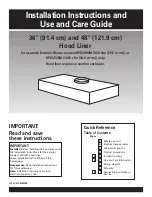
3
EN
READ THESE INSTRUCTIONS BEFORE YOU START INSTALLING THIS RANGEHOOD
READ AND SAVE THESE INSTRUCTIONS
WARNING: - TO REDUCE THE RISK OF A RANGE TOP GREASE FIRE: Never leave surface units unattended at high settings. Boilovers
cause smoking and greasy spillovers that may ignite. Heat oils slowly on low or medium setting. Always turn hood ON when cooking at high
heat or when flambeing food (i.e. Crepes Suzette, Cherries Jubilee, Peppercorn Beef Flambè). Clean ventilating fans frequently. Grease
should not be allowed to accumulate on fan or filter. Use proper pan size. Always use cookware appropriate for the size of the surface element.
WARNING: - TO REDUCE THE RISK OF INJURY TO PERSONS IN THE EVENT OF A RANGE TOP GREASE FIRE, OBSERVE THE
FOLLOWING: SMOTHER FLAMES with a close-fitting lid, cookie sheet, or metal tray, then turn off the burner. BE CAREFUL TO PREVENT
BURNS. If the flames do not go out immediately EVACUATE AND CALL THE FIRE DEPARTMENT. NEVER PICK UP A FLAMING PAN - You
may be burned. DO NOT USE WATER, including wet dishcloths or towels - a violent steam explosion will result. Use an extinguisher ONLY if:
1. You know you have a Class ABC extinguisher, and you already know how to operate it. 2. The fire is small and contained in the area where
it started. 3. The fire department is being called. 4. You can fight the fire with your back to an exit.
CAUTION: To Reduce The Risk Of Fire And Electric Shock, Install This RangeHood Only With Remote Blower Models Rated Maximum. 4,2 A
suitable for use with solid stade speed controls.
WARRANTY & SERVICE
This rangehood carries a limited warranty against manufacturer’s defects. To obtain warranty service, contact the dealer from whom you
purchased the rangehood, or the local Faber distributor. If you cannot identify a local Faber distributor, contact Faber USA at (508) 358-5353 for
the name of a distributor in your area.
USE AND CARE INFORMATION
This rangehood system is designed to remove smoke, cooking vapors and odors from the cooktop area. This unit also has several features
to insure operator safety.
VENTING REQUIREMENTS
Determine which venting method is best for your application. Ductwork can extend either through the wall or the roof.
The length of the ductwork and the number of elbows should be kept to a minimum to provide efficient performance. The size of the ductwork
should be uniform. Do not install two elbows together. Use duct tape to seal all joints in the ductwork system. Use caulking to seal exterior wall
or floor opening around the cap. Flexible ductwork is not recommended. If it is used, each foot of flexible ductwork used is equivalent to two feet
of straight metal ductwork when calculating the ductrun length. Thus, a flexible elbow equals two standard elbows.
Make sure there is proper clearance within the wall or floor for exhaust duct before making cutouts. Do not cut a joist or stud unless absolutely
necessary. If a joist or stud must be cut, then a supporting frame must be constructed. For best results, remote blowers should transition to 10"
round duct as soon as possible. If small ducting is used, it should be transitioned to 9 or 10" round as soon as possible.
WARNING - To Reduce The Risk Of Fire, Use Only Metal Ductwork.
ELECTRICAL REQUIREMENTS
A 120 volt, 60 Hz AC-only electrical supply is required on a separate 15 amp circuit, fused on both sides of the line. A time-delay fuse or circuit
breaker is recommended. The fuse must be sized per local codes in accordance with the electrical rating of this unit as specified on the serial/
rating plate located inside the unit near the field wiring compartment. THIS UNIT MUST BE CONNECTED WITH COPPER
WIRE ONLY. Wire sizes must conform to the requirements of the National Electrical Code, ANSI/NFPA 70 - latest edition, and all local codes and
ordinances. Wire size and connections must conform with the rating of the appliance. Copies of the standard listed above may be obtained
from:
National Fire Protection Association
Batterymarch Park
Quincy, Massachusetts 02269
• Venting system MUST terminate outside the home.
• DO NOT terminate the ductwork in an attic or other enclosed space.
• DO NOT use 4" laundry-type wall caps.
• Flexible-type ductwork is not recommended.
• DO NOT obstruct the flow of combustion and ventilation air.
• Failure to follow venting requirements may result in a fire.
!
WARNING


































